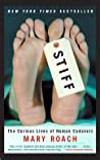
Death. It doesn’t have to be boring.
Well that’s quite a book. I’ve been wanting to try out one of Mary Roach’s books for a while and this one came up on the (digital) library, so I thought I’d give it a try. In a nutshell, it goes into the process of what happens right up to and after you die (including brain death and organ donation) along with the various things that might be done with your body afterwards (such as medical training and testing various products along with alternatives to burial).
“What I do is, I think of them as wax.”
Theresa is practicing a time-honored coping method: objectification. For those who must deal with human corpses regularly, it is easier (and, I suppose, more accurate) to think of them as objects, not people.
It’s a fascinating look into things you just don’t often think of. I quite enjoyed it.
One particularly fun thi8ngs that makes Mary Roach worth reading is her sense of humor through the book. A few examples:
So similar in their treatment were the dead to ordinary items of commerce that every now and then boxes would be mixed up in transit. James Moores Ball, author of The Sack-’Em-Up Men, tells the tale of the flummoxed anatomist who opened a crate delivered to his lab expecting a cadaver but found instead “a very fine ham, a large cheese, a basket of eggs, and a huge ball of yarn.” One can only imagine the surprise and very special disappointment of the party expecting very fine ham, cheese, eggs, or a huge ball of yarn, who found instead a well-packed but quite dead Englishman.
Out behind the University of Tennessee Medical Center is a lovely, forested grove with squirrels leaping in the branches of hickory trees and birds calling and patches of green grass where people lie on their backs in the sun, or sometimes the shade, depending on where the researchers put them.
The last feature to be posed is the mouth, which will hang open if not held shut. Theo is narrating for Nicole, who is using a curved needle and heavy-duty string to suture the jaws together. “The goal is to reenter through the same hole and come in behind the teeth,” says Theo. “Now she’s coming out one of the nostrils, across the septum, and then she’s going to reenter the mouth. There are a variety of ways of closing the mouth,” he adds, and then he begins talking about something called a needle injector. I pose my own mouth to resemble the mouth of someone who is quietly horrified, and this works quite well to close Theo’s mouth. The suturing proceeds in silence.
Arterial embalming didn’t begin to catch on in earnest until the American Civil War. Up until this point, dead U.S. soldiers were buried more or less where they fell. Their families had to send a written request for disinterment and ship a coffin capable of being hermetically sealed to the nearest quartermaster office, whereupon the quartermaster officer would assign a team of men to dig up the remains and deliver them to the family. Often the coffins that the families sent were not hermetically sealed—who knew what “hermetically” meant? Who knows now?—and they soon began to stink and leak. At the urgent pleadings of the beleaguered delivery brigades, the army set about embalming its dead, some 35,000 in all.
At Wayne State, cadavers were leaned forward over a simulated car window and dropped from varying heights (simulating varying speeds) so that their foreheads hit the glass. (Contrary to popular impression, impact test cadavers were not typically ushered into the front seats of actual running automobiles, driving being one of the other things cadavers don’t do well. More often than not, the cadaver was either dropped or it remained still while some sort of controllable impacting device was directed at it.)
To quote Vivian Nutton, author of “The Anatomy of the Soul in Early Renaissance Medicine” in The Human Embryo, “Analogies drawn from the inspection of hen’s eggs foundered on the objection that man was not a chicken.”
The killer, Andrew Lyons, shot a man in the head in September 1973 and left him brain-dead. When Lyons’s attorneys found out that the victim’s family had donated his heart for transplantation, they tried to use this in Lyons’s defense: If the heart was still beating at the time of surgery, they maintained, then how could it be that Lyons had killed him the day before? They tried to convince the jury that, technically speaking, Andrew Lyons hadn’t murdered the man, the organ recovery surgeon had.
Like I said. Worth reading.